Birds come in all shapes and sizes. Some are small and slim, while others are big and round. You might have seen a bird that looks a little chubby, and you might wonder, “Are there fat birds?” The answer is yes! Some birds are fat because of the way their bodies work, and this fat helps them survive in different situations. In this article, we will talk about why some birds are fat, the best foods to help birds gain fat, 15 of the fattest bird breeds, and the pros and cons of having extra fat on birds.
list of 20 Fat Birds
| # | Bird Name | Why They’re Fat | Fun Fact |
|---|---|---|---|
| 1 | Common Eider | Thick body fat to survive cold waters. | Their down feathers are used in high-quality bedding. |
| 2 | Emperor Penguin | Large fat reserves for insulation against Antarctic cold. | Famous for long migrations and incubating eggs in harsh conditions. |
| 3 | American Robin | Gains weight in winter to stay warm. | One of the first birds to return in spring. |
| 4 | Atlantic Puffin | Fat for insulation in cold Atlantic waters. | Can catch multiple fish at once using their colorful beaks. |
| 5 | Keas | Stores fat for survival in chilly alpine environments. | Known for their playful and curious nature. |
| 6 | Northern Cardinal | Plump in winter to stay warm. | Often seen in gardens and bird feeders during colder months. |
| 7 | Eastern Bluebird | Stock up on fat for energy and warmth during winter. | Their bright plumage makes them a favorite among birdwatchers. |
| 8 | Mallard Duck | Becomes plump in winter for warmth. | Males are known for their vibrant green heads. |
| 9 | Wild Turkey | Becomes stocky, especially in fall, to prepare for winter. | Can fly short distances and are often seen foraging. |
| 10 | Ringed Parakeet | Stores fat to remain healthy in warm climates. | Known for their bright green feathers and loud calls. |
| 11 | Pigeon | Becomes plump in urban areas where food is abundant. | Excellent navigators, can find their way home over long distances. |
| 12 | Crested Pigeon | Adapts to city living by storing extra fat. | Known for their distinct feather crest and cooing calls. |
| 13 | Junglefowl (Indian Hen) | Stocky body, gains weight quickly if food is plentiful. | Ancestors of the modern domesticated chicken. |
| 14 | Blue Tit | Can become plump during fall and winter to survive cold. | Often seen hanging upside down to grab food from feeders. |
| 15 | Gadwall Duck | Develops fat reserves during cold winters. | Often seen alone or in small groups rather than large flocks. |
| 16 | Great Horned Owl | Stores fat to help survive colder temperatures. | Known for its distinct ear tufts and hooting calls. |
| 17 | White-tailed Eagle | Gains fat to sustain long flights and survive harsh conditions. | One of the largest birds of prey with a broad wingspan. |
| 18 | Bald Eagle | Stores fat for endurance and to survive in cold environments. | Known for its iconic white head and yellow beak. |
| 19 | Mandarin Duck | Known to become plump in winter months. | Famous for its colorful plumage and unique markings. |
| 20 | Snow Goose | Becomes fat to survive cold winters in Northern regions. | Migrates in large flocks, traveling long distances. |
This list includes a mix of birds from various environments and regions that store fat either for warmth or to survive colder conditions.
Why Are Some Birds Fat and Others Not?
Birds store fat in their bodies for a few important reasons. Fat helps them survive when food is hard to find or when the weather gets really cold. Birds that live in cold places or fly long distances often become fat during certain times of the year to help them survive. For example:
- Surviving Winter: Some birds get fat in the winter to stay warm. This is because fat acts like a blanket, keeping their body heat inside. Birds like the Northern Cardinal and European Robin put on extra fat to survive the cold months.
- Flying Long Distances: Some birds fly for long distances, like the puffin and geese. Before they start their journey, they eat a lot to store fat. The fat gives them energy during their long flights.
- Living in Cold Places: Birds that live in cold areas, like the Common Eider or Kea, build up fat to keep warm and safe from the freezing weather.
On the other hand, birds that don’t live in cold areas or don’t need to travel long distances don’t get fat. They tend to stay slim and healthy.
Best Foods to Help Birds Gain Fat
If you’re trying to help your pet bird gain weight or want to make sure wild birds are ready for winter, there are some foods that are really good at helping them get fat. These foods are full of fat and energy, which help birds stay healthy:
- Sunflower Seeds: These seeds are very high in fat and protein, which birds love.
- Nuts (especially Peanuts): Nuts like peanuts, almonds, and walnuts are packed with fat. Birds love them!
- Suet: This is a type of fat that is often given to birds in the winter to keep them warm and strong.
- Fruits: Birds enjoy fruits like apples, bananas, and grapes, which give them energy and nutrients.
- Oils: Birds also enjoy vegetable oil, which is full of healthy fat that gives them extra energy.
If you’re feeding birds, it’s important not to give them too much fat. Just the right amount will keep them healthy and full of energy.
The Fattest Bird Breeds
Here are 15 birds that are known for being fat or having a round body shape. Some of these birds are fat because of the weather, while others are naturally plump.
Northern Cardinal (Cardinalis cardinalis)
Size: 8-9 inches
Habitat: Woodlands, gardens, shrubby areas, and backyards
Diet: Seeds, fruits, insects

The Northern Cardinal is a striking and popular bird, easily recognized by its bright red plumage. Males are especially known for their vivid red color, while females have a more subtle, brownish-red appearance with warm reddish highlights. This bird is commonly found in woodlands, gardens, and backyards, where it feeds on seeds, fruits, and occasionally insects. Northern Cardinals are non-migratory and can be seen year-round in many areas. Their distinctive, melodious song adds to their charm, and they are a favorite among birdwatchers. The red coloration of the male is thought to be an important trait for attracting mates, making the Northern Cardinal both beautiful and fascinating to observe.
Why They’re Fat: Northern Cardinals become plump in winter to stay warm and healthy. Their fat helps them survive the cold weather.
Fun Fact: Cardinals are often found in backyards, where they enjoy sunflower seeds and other bird food.
European Robin (Erithacus rubecula)
Size: 5-6 inches
Habitat: Woodlands, gardens, parks, and hedgerows
Diet: Insects, worms, berries, seeds

European Robin
The European Robin is a small and friendly bird, often seen in gardens and parks, especially during the colder months. Known for its distinctive red-orange breast, this bird has a greyish-brown back and a white belly. Robins are commonly spotted hopping around on the ground, searching for insects, worms, and seeds. During autumn and winter, they also enjoy eating berries. European Robins are known for their cheerful and melodic song, which they often sing throughout the year, making them a favorite among birdwatchers. While they can be quite territorial, their curious and bold nature often brings them close to humans, especially when food is available.
Why They’re Fat: European Robins also gain fat to stay warm in the winter months. Their plump bodies help them survive when it’s cold outside.
Fun Fact: Robins are very friendly and can often be seen hopping around in gardens even when it’s snowy outside.
Atlantic Puffin (Fratercula arctica)
Size: 10-12 inches
Habitat: Coastal cliffs, islands, and rocky shorelines
Diet: Fish, squid, small marine creatures

Atlantic Puffin
The Atlantic Puffin is a charming and colorful seabird known for its striking appearance, with a large, colorful beak and black-and-white plumage. Often called “sea parrots” because of their vibrant beaks, puffins are typically found along the coastal cliffs and islands of the North Atlantic.
They are expert divers, plunging into the water to catch fish, squid, and small marine creatures, which they carry in their beaks to feed their young. Puffins are most commonly seen in summer when they return to their nesting colonies. Outside of the breeding season, they spend much of their time at sea. Their clumsy, waddling walk on land is in sharp contrast to their graceful flying and swimming abilities, making them both endearing and fascinating to watch.
Why They’re Fat: Puffins are fat because they need thick layers of fat to keep warm in cold waters. They also use their fat for energy.
Fun Fact: Puffins have colorful beaks and can catch lots of fish in one go!
American Robin (Turdus migratorius)
Size: 9-11 inches
Habitat: Lawns, gardens, forests, parks, and suburbs
Diet: Worms, insects, fruits, berries
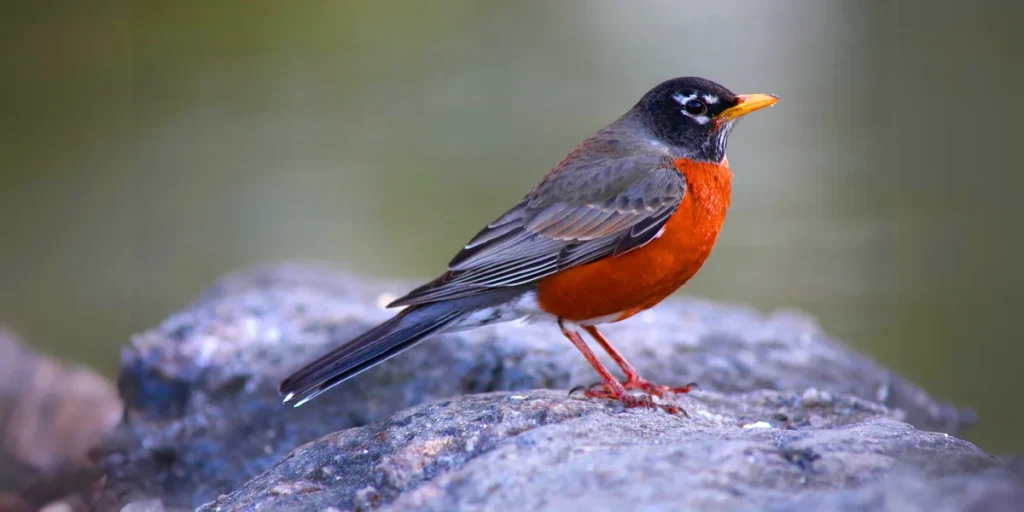
American Robin
The American Robin is one of the most well-known and widely recognized birds in North America. It has a vibrant red-orange breast, a grey-brown back, and a white belly, making it easy to spot, especially in spring and summer. Robins are often seen hopping across lawns and gardens in search of worms and insects, but they also enjoy fruits and berries, particularly in the fall.
Their cheerful, melodious song is a sign of spring, and many people associate their return with the changing of seasons. American Robins are migratory birds, heading south during the winter months, but they are a common sight in gardens and parks throughout the warmer months. With their bright colors and pleasant song, they are a favorite among birdwatchers and nature lovers.
Why They’re Fat: Just like the European Robin, American Robins put on weight during the winter to stay warm and survive the cold.
Fun Fact: American Robins are one of the first birds to come back in spring, which makes them a sign that warmer weather is coming!
Keas (Nestor notabilis)
Size: 18-20 inches
Habitat: Mountainous regions, forests, and alpine areas of New Zealand
Diet: Fruits, seeds, insects, small animals
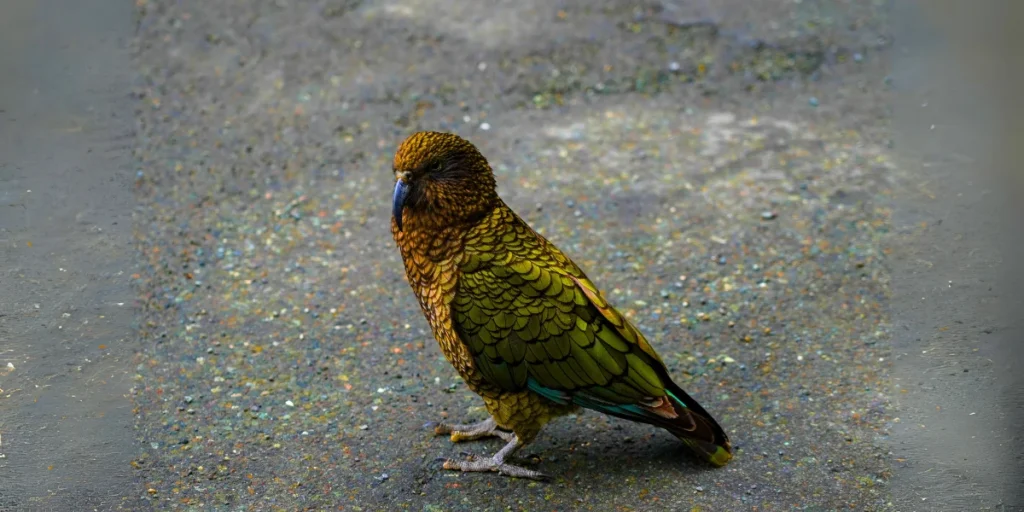
Keas
The Kea is a large, green parrot native to the rugged mountains of New Zealand. Known for its playful and curious nature, the Kea is often seen exploring its environment and interacting with both people and other animals. This bird has vibrant green plumage with a mix of orange and yellow feathers on its wings, making it quite striking. Keas are omnivores, which means they eat a variety of foods, including fruits, seeds, insects, and even small animals.
They are especially known for their intelligence, problem-solving abilities, and mischievous behavior, often seen attempting to open bags, cars, or even sheds in search of food. Despite their cheeky nature, Keas are highly social birds that live in small groups and are well adapted to survive in harsh alpine conditions. Their thick layer of fat helps them withstand the cold weather of New Zealand’s mountains, making them resilient to the harsh conditions of their habitat.
Why They’re Fat: Keas, which live in New Zealand’s mountains, have thick fat to protect them from the cold.
Fun Fact: Keas are playful birds and like to explore new things around them.
Common Eider (Somateria mollissima)
Size: 20-28 inches
Habitat: Coastal areas, rocky shorelines, and islands in the Northern Hemisphere
Diet: Mollusks, crustaceans, fish, seaweed
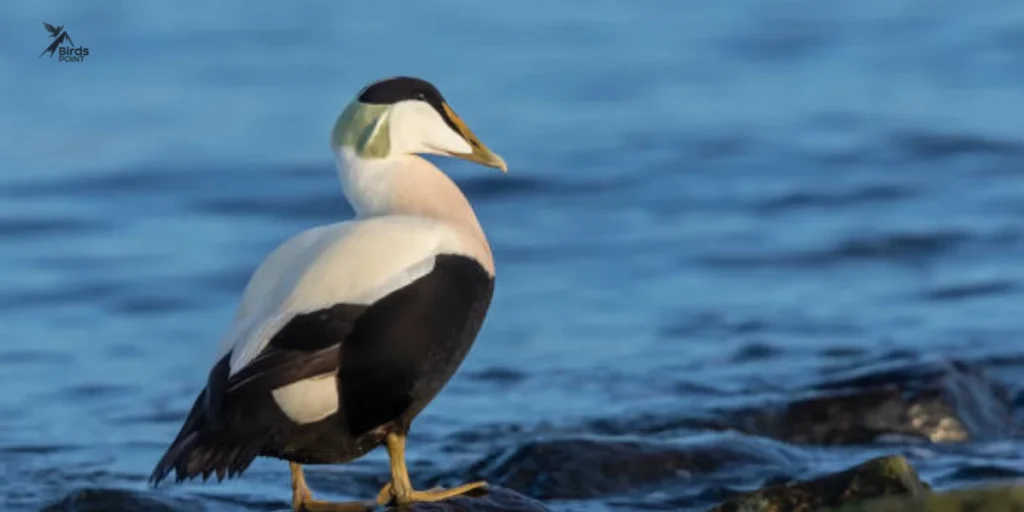
Common Eider
The Common Eider is a large sea duck known for its striking appearance and unique adaptations to life in cold coastal environments. Males are easily recognized by their black and white plumage, while females have a more subdued brown appearance. These ducks are often found in the cold waters of the Northern Hemisphere, especially along coastal areas, rocky shorelines, and islands, where they dive to find food like mollusks, crustaceans, and small fish.
Eiders are excellent divers and spend a lot of time underwater searching for food, which provides them with the energy and nutrients needed to survive in harsh conditions. One of the most notable features of the Common Eider is its thick layer of fat, which helps it stay warm in the freezing waters. In fact, their down feathers are so insulating that they are highly valued and used to make warm clothing and bedding. The Common Eider’s ability to thrive in cold environments, combined with its impressive diving skills, make it a fascinating and resilient bird.
Why They’re Fat: Common Eiders are fat because their fat helps them stay warm while swimming in cold waters.
Fun Fact: The soft down feathers of Eiders are used to make warm jackets and bedding!
Blue Tit (Cyanistes caeruleus)
Size: 4-5 inches
Habitat: Woodlands, gardens, parks, and hedgerows
Diet: Insects, seeds, berries
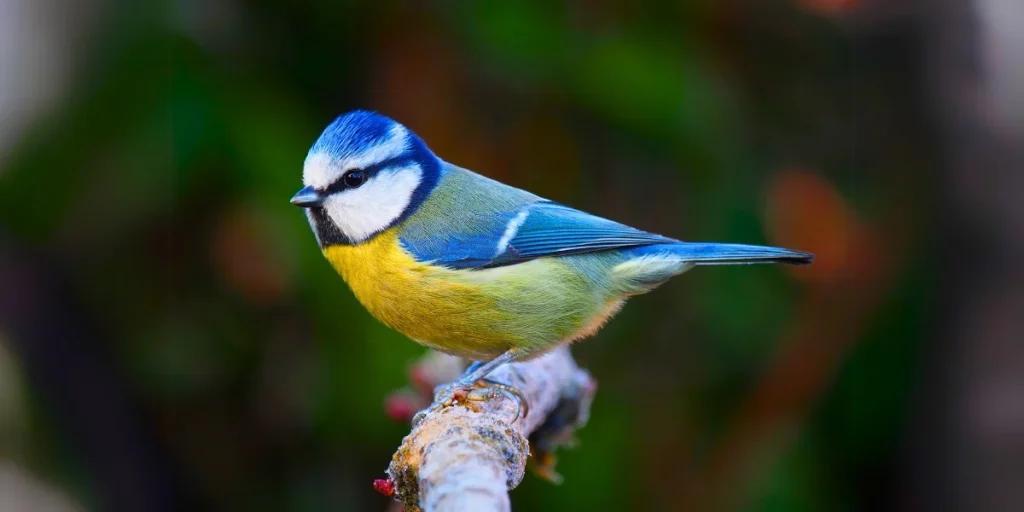
Blue Tit
The Blue Tit is a small, colorful bird with a bright blue cap, yellow belly, and greenish wings. It is commonly found in woodlands, gardens, and parks across Europe. Blue Tits are known for their energetic behavior, often flitting around looking for insects, seeds, and berries. They are quick and agile, sometimes hanging upside down to reach food. These birds are friendly and curious, often seen visiting bird feeders. Their cheerful chirps and vivid colors make them a favorite among birdwatchers.
Why They’re Fat: Blue Tits build up fat during the winter months to stay warm. They often get plump when food is easy to find.
Fun Fact: Blue Tits are very clever birds and love to hang upside down to grab food!
Gadwall Duck (Mareca strepera)
Size: 19-22 inches
Habitat: Wetlands, lakes, ponds, and marshes
Diet: Aquatic plants, seeds, insects, small fish

Gadwall Duck
The Gadwall Duck is a medium-sized duck with a subtle, elegant appearance. Males have a greyish-brown body with a black tail, while females are mostly brown with lighter markings. Gadwalls are commonly found in wetland areas like lakes, ponds, and marshes. They feed on aquatic plants, seeds, insects, and small fish, often dabbling in shallow waters. These ducks are peaceful and often seen swimming in groups. While not as colorful as some other ducks, their calm demeanor and unique patterns make them a pleasant sight for birdwatchers.
Why They’re Fat: Gadwall Ducks get fat to survive the cold winter months. They store fat to have enough energy when food is hard to find.
Fun Fact: Gadwalls like to stay in small groups instead of large flocks.
Ringed Parakeet (Psittacula krameri)
Size: 16-18 inches
Habitat: Woodlands, parks, gardens, and urban areas
Diet: Seeds, fruits, nuts, berries
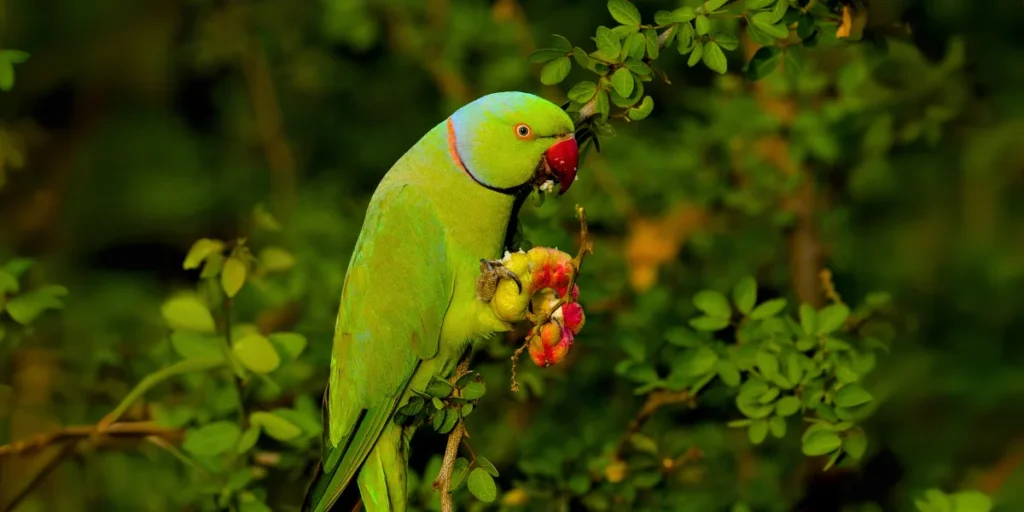
Ringed Parakeet
The Ringed Parakeet, also known as the Rose-ringed Parakeet, is a colorful bird with bright green feathers and a distinctive black ring around its neck. Males have a more prominent ring, while females may have a lighter or absent ring. These parakeets are commonly found in woodlands, parks, and even urban areas, especially in parts of Asia and Africa, and they’ve also become common in some cities around the world. Ringed Parakeets feed on a variety of seeds, fruits, nuts, and berries. They are social birds and are often seen in flocks, making loud, cheerful calls. Their vivid green plumage and lively behavior make them a favorite among birdwatchers and pet owners alike.
Why They’re Fat: Ringed Parakeets, which come from South Asia, are naturally plump and often eat a lot of seeds and fruit to stay healthy.
Fun Fact: These parakeets are very colorful and love to squawk loudly!
Pigeon (Columba livia)
Size: 12-14 inches
Habitat: Cities, towns, cliffs, and farmlands
Diet: Seeds, grains, fruits
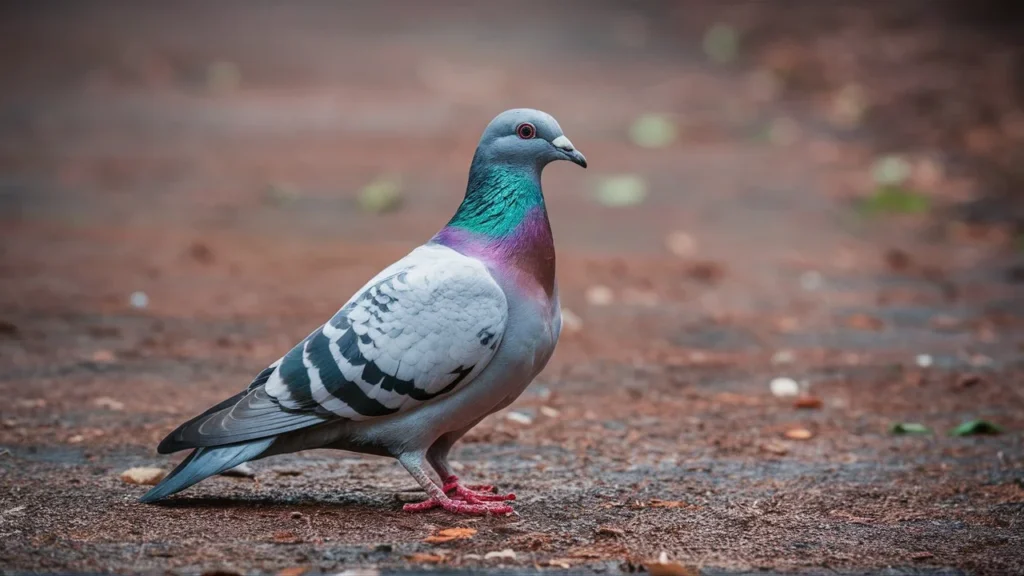
Pigeon
Pigeons are common birds found in cities, towns, and rural areas. They have smooth, grayish feathers with a slightly iridescent sheen on their necks. Pigeons eat seeds, grains, and fruits, and are often seen pecking at the ground in parks or streets. They are very social birds, usually found in groups, and are known for their gentle cooing sounds. Pigeons are hardy and can adapt to living in many different environments, making them one of the most widespread bird species in the world.
Why They’re Fat: Pigeons in cities can become fat because there is lots of food around. Their extra fat helps them survive in tough environments.
Crested Pigeon (Ocyphaps lophotes)
Size: 13-15 inches
Habitat: Open woodlands, grasslands, and suburban areas in Australia
Diet: Seeds, grains, fruits, and plants

Crested Pigeon
The Crested Pigeon is a medium-sized bird known for its distinctive, spiky crest on its head. It has soft gray feathers with a subtle pinkish hue on its chest and a long, pointed tail. Native to Australia, Crested Pigeons are often found in open woodlands, grasslands, and even urban areas. They feed on seeds, grains, and fruits, typically foraging on the ground. These pigeons are peaceful and social birds, often seen in small flocks. Their unique appearance and gentle cooing calls make them a favorite among birdwatchers.
Fun Fact: Pigeons can find their way home over long distances, even when they’re far away!
Why They’re Fat: Crested Pigeons also get fat because of the easy food supply in cities.
Fun Fact: These pigeons are known for their cool feather crest on top of their heads.
Junglefowl (Gallus gallus)
Size: 22-30 inches
Habitat: Forests, grasslands, and scrublands of South Asia
Diet: Seeds, fruits, insects, small plants
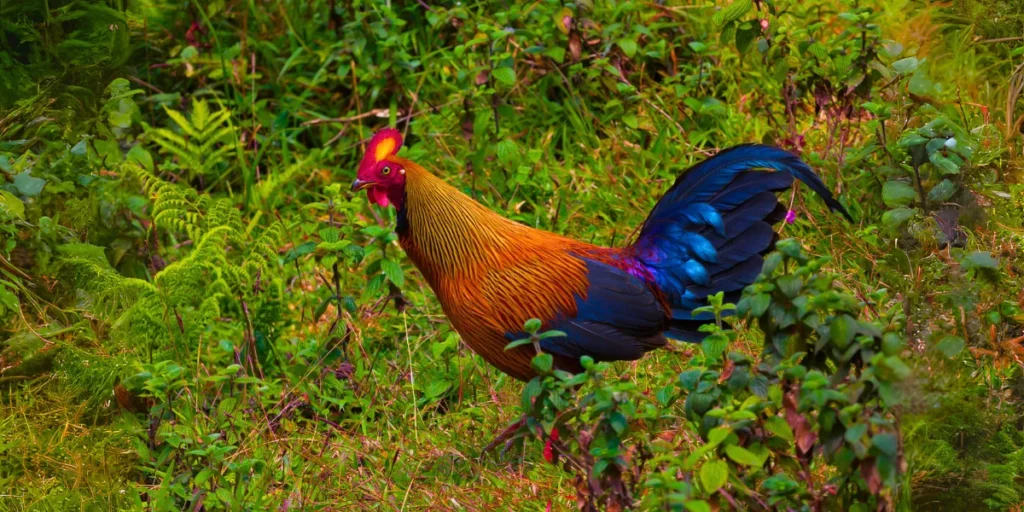
Junglefowl
The Junglefowl is a wild bird native to the forests and grasslands of South Asia, especially India and Sri Lanka. Known for its colorful feathers, the male Junglefowl has bright red, orange, and gold plumage, with a striking red comb on its head. Females are more subdued in color, typically brown or olive. These birds are omnivores, feeding on seeds, fruits, insects, and small plants. Junglefowls are often found on the ground, scratching for food. They are the ancestors of the domesticated chicken, and their natural habitat is usually dense vegetation where they can hide from predators. Their calls are loud and distinctive, and they are highly territorial.
Why They’re Fat: Junglefowls, which are the ancestors of chickens, are naturally stocky and gain weight easily when food is available.
Fun Fact: Junglefowls are where all domesticated chickens come from!
Emperor Penguin (Aptenodytes forsteri)
Size: 39-48 inches
Habitat: Antarctic ice and coastal regions
Diet: Fish, squid, krill

Emperor Penguin
The Emperor Penguin is the largest of all penguin species, easily recognized by its striking black and white plumage with a yellow-orange patch on its neck. Found only in Antarctica, these penguins are well-adapted to the freezing cold, with a thick layer of fat and dense feathers that keep them warm. Emperor Penguins are excellent swimmers and dive deep into the cold waters to hunt for fish, squid, and krill.
They are social birds and live in large colonies, especially during breeding season. The males play a key role in incubating the eggs, keeping them warm by balancing them on their feet and covering them with a flap of skin. Despite the harsh conditions of their environment, Emperor Penguins are resilient and have fascinating behaviors that make them one of the most iconic species in the animal kingdom.
Why They’re Fat: Emperor Penguins are large, heavy birds with a thick layer of fat that helps them survive the freezing cold of Antarctica.
Fun Fact: Emperor Penguins are famous for their long journeys and how they care for their eggs in the harshest weather.
Mallard Duck (Anas platyrhynchos)
Size: 20-26 inches
Habitat: Lakes, rivers, ponds, wetlands, and parks
Diet: Seeds, aquatic plants, insects, small fish
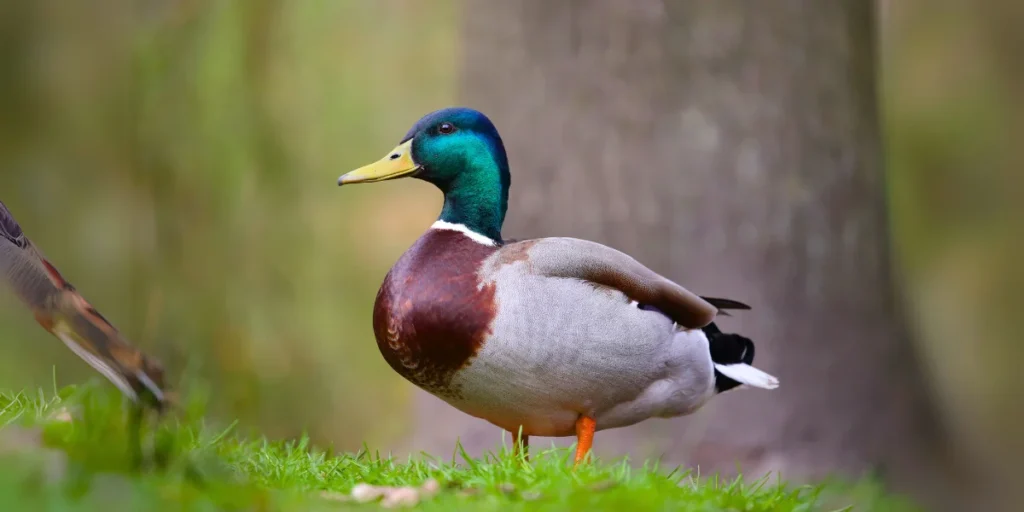
Mallard Duck
The Mallard Duck is one of the most well-known and common ducks found in North America, Europe, and parts of Asia. The male Mallard, or drake, has a shiny green head, yellow beak, and a distinctive white ring around his neck, while the female is brown and mottled, which helps her blend into her surroundings. Mallards are often found in freshwater habitats like lakes, rivers, and ponds, where they feed on seeds, aquatic plants, insects, and small fish.
They are dabbling ducks, which means they feed by tipping forward in the water to forage. Mallard Ducks are social birds and can be seen in small groups or large flocks, especially during migration. Their familiar quacking sounds and colorful plumage make them a favorite among birdwatchers and nature lovers.
Why They’re Fat: Mallard Ducks can get fat in the winter when food is easy to find. They use the extra fat to stay warm and healthy.
Fun Fact: Mallard Ducks are known for their bright green heads and brown bodies.
Wild Turkey (Meleagris gallopavo)
Size: 40-50 inches
Habitat: Woodlands, grasslands, and forests of North America
Diet: Seeds, nuts, fruits, insects, and small plants
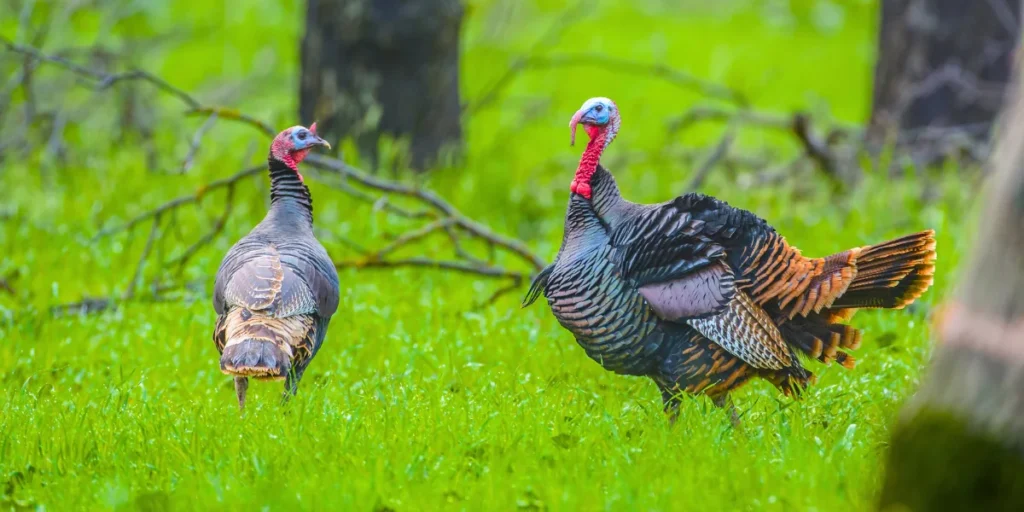
Wild Turkey
The Wild Turkey is a large, striking bird native to North America. Males, known as toms, are famous for their colorful feathers, large fan-shaped tail, and a fleshy wattle that hangs from their beak, known as a “snood.” Females are smaller and less colorful, with brown and gray feathers. Wild Turkeys are ground-dwelling birds that prefer woodlands, grasslands, and forests, where they forage for seeds, nuts, fruits, insects, and small plants. They are known for their strong legs and ability to run quickly on the ground, though they can also fly short distances.
Wild Turkeys are social animals, often seen in flocks, especially during the winter months. They are most active during the day, foraging for food and making distinctive gobbling calls, especially during mating season. Their impressive size and unique behaviors make them one of the most iconic birds in North America.
Why They’re Fat: Wild Turkeys put on extra fat in the fall to get ready for the cold winter months.
Fun Fact: Wild Turkeys are strong birds that can fly for short distances and are often seen foraging for food.
What Bird is Heavy?
Some birds are really heavy because of their size and muscles, even though they aren’t fat. The Ostrich, for example, is the heaviest bird and can weigh up to 350 pounds! Other heavy birds include the Emu (around 120 pounds) and the Kori Bustard (which weighs about 40 pounds). These birds are big, but not fat.
Which Bird Has More Weight?
The Ostrich is the heaviest bird in the world. It can weigh up to 350 pounds and is the largest living bird. The Ostrich cannot fly, but it can run very fast. Its weight helps protect it from predators because it is too big for most animals to attack.
Advantages and Disadvantages of Fat in Birds
Advantages of Having Fat:
- Surviving Winter: Fat helps birds stay warm during cold weather. It acts like a blanket, keeping them comfortable when the temperatures drop.
- Energy for Long Trips: Birds that migrate need extra fat to give them energy for their long flights. This fat helps them travel across countries or even continents.
- Protection from Predators: Fat can act as a shield, protecting birds from attacks by predators.
- Better Health: Birds that have enough fat don’t have to worry as much about food shortages and can stay healthy for longer periods.
Disadvantages of Having Fat:
- Harder to Fly: Birds with too much fat might have trouble flying quickly or easily. Fat can slow them down.
- Health Problems: Birds with too much fat, especially in captivity, might get sick. They could develop diseases like fatty liver disease or heart problems.
- Less Movement: Birds that are too fat might have trouble moving around or foraging for food. This could be a problem if they need to find food in a hurry.
Conclusion: Fat Birds and Their Amazing Adaptations
Fat birds might look funny, but they are experts at surviving in tough environments. Whether they’re using fat to stay warm in the winter, get ready for migration, or protect themselves from predators, fat is an important part of their survival. But, like all things in nature, balance is important. Too much fat can be harmful, while too little can make survival harder. Understanding why birds get fat helps us appreciate how they adapt and thrive in the wild.
FAQs
1. What are fat birds?
Fat birds are those that store extra body fat, often to help them survive harsh climates, particularly cold winters, or to provide energy for migration.
2. Why do some birds get fat in winter?
Birds accumulate fat in winter to provide insulation against the cold and to have enough energy to survive when food is less available.
3. Which bird is the fattest?
The Common Eider and Emperor Penguin are among the fattest birds, known for their thick layers of fat that help them survive in cold environments.
4. Why do penguins have so much fat?
Penguins, especially the Emperor Penguin, store fat to insulate their bodies from freezing Antarctic temperatures and help them survive in harsh conditions.
5. Do all birds get fat?
No, not all birds get fat. Only certain species, especially those living in cold climates or migratory birds, accumulate fat for warmth or energy storage.
6. What foods make birds fat?
Birds gain weight by eating high-energy foods such as seeds, nuts, insects, and fruits, especially during fall and winter when they prepare for colder months.
7. Which birds store the most fat?
Some birds known for storing the most fat include the Common Eider, Atlantic Puffin, Keas, and Wild Turkey, which accumulate fat for insulation or survival during migration.
8. Can fat birds fly?
Yes, many fat birds can still fly, but some may be less agile or have shorter flights when they are at their heaviest, such as the Wild Turkey.
9. Why are some parrots fat?
Parrots like the Keas and Ringed Parakeet store fat to stay healthy, particularly in environments where food is abundant or where fat helps them endure cooler climates.
10. Do birds get fat in cities?
Yes, urban birds like Pigeons and Crested Pigeons can become plump because food is plentiful in cities, making it easy for them to store extra fat.
